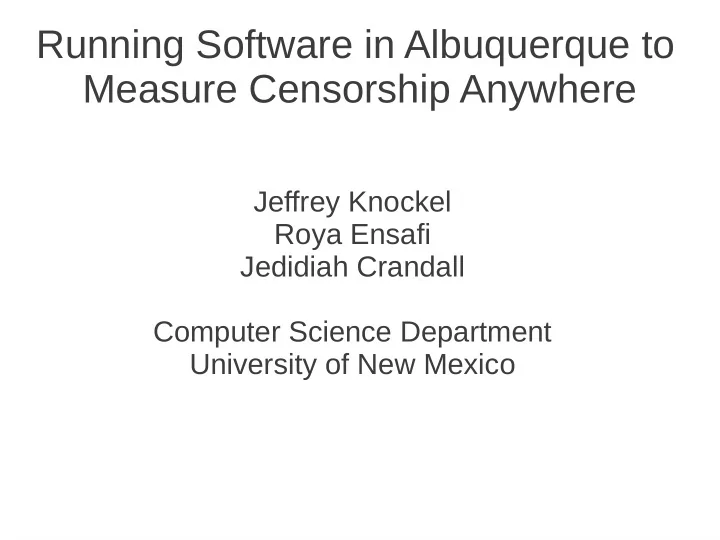

Running Software in Albuquerque to Measure Censorship Anywhere Jeffrey Knockel Roya Ensafi Jedidiah Crandall Computer Science Department University of New Mexico
When will Desert Storm invasion begin?
No access to Pentagon
Watch Dominos outside Pentagon
Pentagon deliveries normally
Night before an invasion
Moral of the story We can measure what is happening in a thing without being in that thing
Question Server Clients Can clients connect to the server? Albuquerque
TCP Connection Server Clients SYN SYNACK ACK Albuquerque
Measurement ● Run measurement software over there ● Problem: cannot get software in there ● Or: – Not in the right city – Not right now ● We don't need measurement software on client, on server, or in between
Client ● Find client with globally incrementing IP ID IP Header Version / IHL / TOS Length ID Flags / Fragment Offset TTL / Protocol Checksum Source IP Destination IP ● Windows XP, FreeBSD, etc. globally increment this ID
Measure # of packets sent ● Ping every second ● 1006, 1007, 1008, 1009… – 1, 1, 1… none sent ● 3003, 3007, 3012, 3016… – 4, 5, 4… some sent ● 4000, 5000, 6200, 7300… – 1000, 1200, 1100… lots sent
Experiment Server Client Forged SYN Albuquerque
No censorship (+1) Server Client SYNACK RST Forged SYN Albuquerque
Server → Client censored (+0) Server Client SYNACK SYNACK … Forged SYN Albuquerque
Client → Server censored (+>1) SYNACK Server Client RST SYNACK RST … Forged SYN Albuquerque
ARIMA time series
Iterative outlier removal
Intervention analysis Server → Client 0 Measured intervention: 15.1 No censorship 5 Client → Server filtering! Client → Server 15
Ethical concerns Can clients sending RST's get them hurt? Ethical Knob ← Decrease clarity Decrease karma →
Future ● Gathering data ● Using other shared finite resources – Reassembly buffers – … ● Other censorship – DNS – DPI – …
SpookyScan Spooky scanning at a distance http://spookyscan.cs.unm.edu
SpookyScan
SpookyScan
SpookyScan
Acknowledgments This material is based upon work supported by the U.S. National Science Foundation under Grant Nos. 0844880, 0905177, and 1017602. Any opinions, findings, and conclusions or recommendations expressed in this material are those of the author(s) and do not necessarily reflect the views of the U.S. National Science Foundation.
Recommend
More recommend